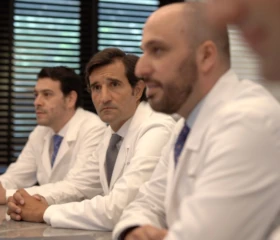Treatment Urinary Fistula
The treatment of urinary fistula is complex and will usually require surgical reconstruction.
Make sure that the surgeons involved are certified to do so, use the latest technologies and achieve the best quality of life for the patient.
- Super-specialized urologists
- Personalized treatment
- Minimally invasive approach
- More than 16,000 patients successfully treated
Treatments for urinary fistulas
They ask us in the Consultation
What is the relationship between urinary fistulas and radiotherapy?
In case of radiotherapy, fistulas usually have a more complex treatment. Radiotherapy is an effective treatment in multiple tumors and its complications are rare. However, on isolated occasions, especially in association with pelvic surgery, it increases the risk of development of fistulas from the urinary tract to the vagina or the gastrointestinal tract.
I have been diagnosed with a urinary fistula, which specialist should treat me?
First of all, an evaluation by a urologist specializing in reconstructive urology should be performed. He or she will adequately evaluate the patient's condition in order to propose an individualized treatment.
I expel gases through the urinary tract, is it serious?
The expulsion of gases through the urine may indicate the existence of a fistula of the urinary tract and the digestive tract. This is a communication between the two. In itself it is not serious. It may be associated with an increase in urinary tract infections. A proper study of the origin of the fistula is necessary, which may be related to urological processes such as previous surgeries or digestive processes such as infections or diverticulitis.
What happens if I have a urinary fistula and do not have surgery?
In case of urinary fistula, either with the vagina or the gastrointestinal tract, involuntary urine leakage or gas emission through the urethra may occur. If not operated, these symptoms do not disappear. Occasionally, fistulas may close spontaneously by placing a bladder catheter, but surgical intervention is usually required.
Team of the Urinary Fistula Unit
Newsof ROC Clinic in Urinary Fistula
Research
Da Vinci and Hugo RAS Platforms for robot-assisted partial nephrectomy: a preliminary prospective comparative analysis of the outcomes.


 +34 912 627 104
+34 912 627 104 Contact
Contact







